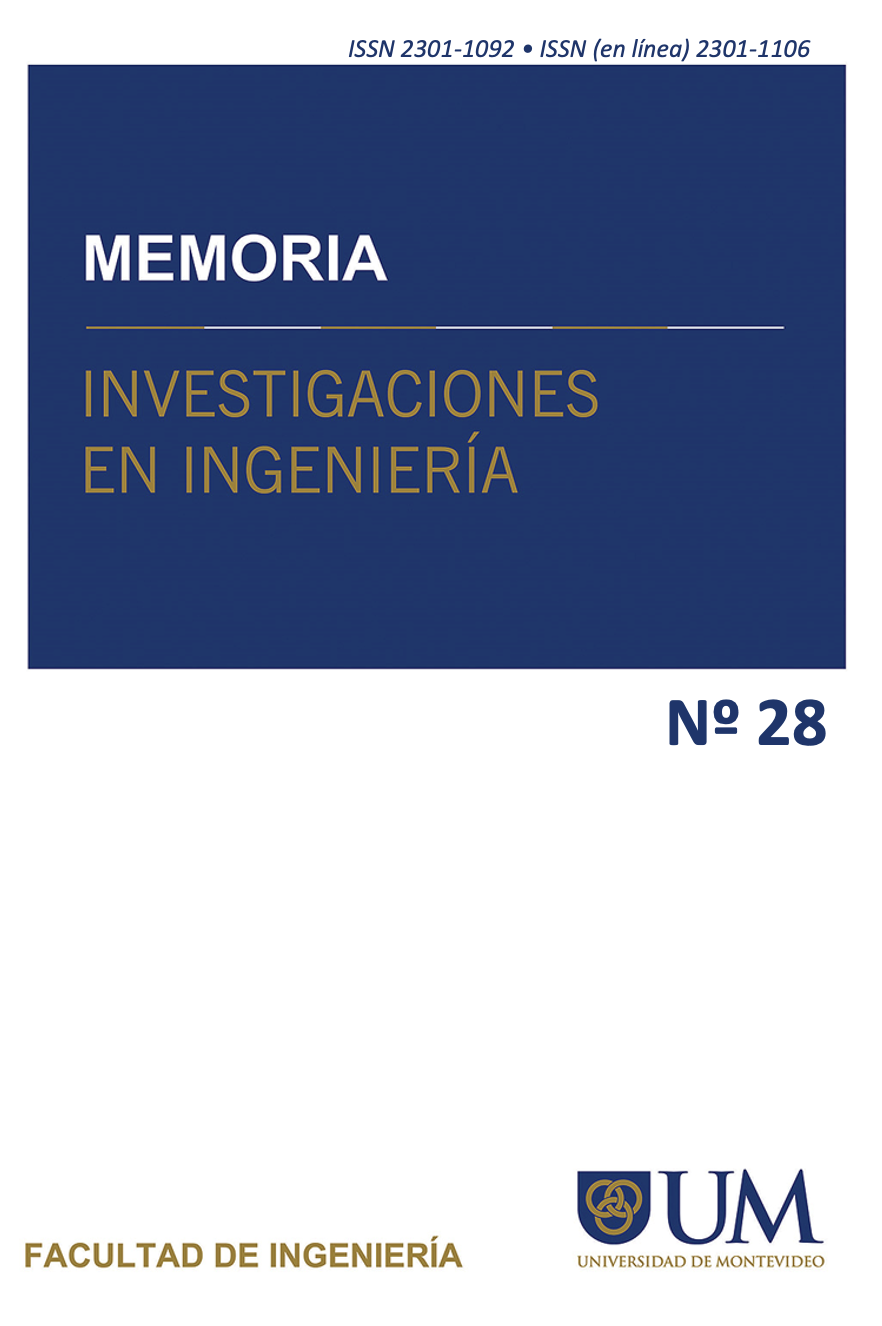Projeto de um sistema de intercomunicação de emergência veicular utilizando circuitos eletrônicos e sensores
DOI:
https://doi.org/10.36561/ING.28.8Palavras-chave:
Intercomunicador veicular, Emergência de trânsito, Prevenção de colisões, Segurança veicularResumo
Neste trabalho, foi projetado um sistema de intercomunicação de emergência veicular, com foco na melhoria da segurança de motociclistas por meio da integração de circuitos eletrônicos e sensores. Utilizando um microcontrolador Arduino UNO R3, módulos GSM SIM900L e sensores ultrassônicos e de proximidade, o sistema é programado em C++ para detectar quedas e disparar alertas automáticas com alta eficiência.
As quedas podem ser detectadas com 95% de precisão e em um alcance de 2 a 100 cm, com tempo médio de resposta de 1,2 segundos, tornando-o adequado para emergências. A capacidade do sistema de enviar alertas rapidamente também foi destacada, aumentando a segurança do usuário em situações críticas que variam de 101 a 150 cm. No entanto, foram identificadas limitações no alcance de detecção, principalmente em distâncias mínimas que variam de 0,02 cm a 1,96 cm e máximas que variam de 151,36 cm a 177,72 cm, medidas que estão fora da faixa de operação, sugerindo a necessidade de mais ajustes no futuro. Este projeto oferece uma solução inovadora, eficiente e fácil de implementar para melhorar a segurança nas estradas, com alto grau de sensibilidade para otimizar a resposta a emergências.
Downloads
Referências
M. A. Espinoza-Mina and A. M. Colina-Vargas, “Characterization of traffic accidents for urban road safety,” Revista Facultad de Ingeniería Universidad de Antioquia, Nov. 2023, https://doi.org/10.17533/udea.redin.20231134
A. Carreras-Coch, J. Navarro, C. Sans, and A. Zaballos, “Communication Technologies in Emergency Situations,” Apr. 01, 2022, MDPI. https://doi.org/10.3390/electronics11071155
M. J. Islam, M. N. Pathan, A. Sultana, and A. Rahman, “An IoT-Based Smart Helmet for Riding Security and Emergency Notification,” in Proceedings - 6th International Conference on Electrical Engineering and Information and Communication Technology, ICEEICT 2024, Institute of Electrical and Electronics Engineers Inc., 2024, pp. 1211–1216. https://doi.org/10.1109/ICEEICT62016.2024.10534489
R. Subramaniyan, S. Kumuran, and J. Kathirvelan, “Smart Helmet System with Wireless Communication through GSM,” in 2024 3rd International Conference on Artificial Intelligence for Internet of Things, AIIoT 2024, Institute of Electrical and Electronics Engineers Inc., 2024. https://doi.org/10.1109/AIIoT58432.2024.10574693
S. Goswami, S. Chakraborty, S. Laha, and A. Dhar, “Enhancement of GSM Security using elliptic curve cryptography algorithm,” in Proceedings - 3rd International Conference on Intelligent Systems Modelling and Simulation, ISMS 2012, 2012, pp. 639–644. https://doi.org/10.1109/ISMS.2012.137
G. M. Debele and X. Qian, “AUTOMATIC ROOM TEMPERATURE CONTROL SYSTEM USING ARDUINO UNO R3 AND DHT11 SENSOR,” 2020.
H. J. Santillán Carranza, J. O. Enríquez Sandoval, and J. F. Bonilla Castro, "Development of a Wireless Educational Tool Based on Raspberry Pi," INGENUITY, vol. 7, no. 1, pp. 13–22, Feb. 2024, https://doi.org/10.29166/ingenio.v7i1.5630
B. MertArduino in CircuitsArduino, “Arduino-Ultrasonic Sensor HC-SR04 With Buzzer Introduction: Arduino-Ultrasonic Sensor HC-SR04 With Buzzer.” [Online]. Available: https://www.instructables.com/Arduino-Ultrasonic-Sensor-HC-SR04-With-Buzzer/
C. Vidal-Silva, M. I. Lineros, G. E. Uribe, and C. J. Olmos, “Electronics for everybody using Arduino: Positive experience in the implementation of hardware-software solutions,” Technological Information, vol. 30, no. 6, pp. 377–386, 2019, https://doi.org/10.4067/S0718-07642019000600377
J. A. Marín-Marín, P. A. García-Tudela, and P. Duo-Terrón, “Computational thinking and programming with Arduino in education: A systematic review for secondary education,” Heliyon, vol. 10, no. 8, p. e29177, Apr. 2024, https://doi.org/10.1016/J.HELIYON.2024.E29177
H. Santillán, A. Mantilla, D. Cárdenas, and P. Wong, “Design of a low-cost portable electrocardiograph for telemedicine application,” Engineering Research Report, no. 26, pp. 244–264, Jul. 2024, https://doi.org/10.36561/ing.26.15
M. Nayak and A. K. Dass, “GSM and Arduino based Smart Home Safety and Security System,” https://doi.org/10.5281/zenodo.7610756
P. Jacko et al., “Remote IoT Education Laboratory for Microcontrollers Based on the STM32 Chips,” Sensors, vol. 22, no. 4, Feb. 2022, https://doi.org/10.3390/s22041440
Arulkumar V., Kavin F., Arulkumar D., and Bharathiraja N., “IoT Sensor Data Retrieval and Analysis in Cloud Environments for Enhanced Power Management,” Journal of Advanced Research in Applied Sciences and Engineering Technology, vol. 45, no. 2, pp. 202–213, May 2024.
A. M. Laukkanen, J. Horáček, and V. Radolf, “Buzzer versus water resistance phonation used in voice therapy. Results obtained with physical modeling,” Biomed Signal Process Control, vol. 66, p. 102417, Apr. 2021, https://doi.org/10.1016/J.BSPC.2021.102417
M. P. Valente and I. B. De Paula, “Sensor based on piezo buzzers for simultaneous measurement of fluid viscosity and density,” Measurement, vol. 152, p. 107308, Feb. 2020, https://doi.org/10.1016/J.MEASUREMENT.2019.107308
A. V. Rojas, J. G. Ibarra, A. Y. Nagano, and F. H. B. Santana, "Curing depth of pit and fissure sealants using diode (LED) emitted light at different distances," Mexican Dental Journal, vol. 19, no. 2, pp. 76–80, Apr. 2015, https://doi.org/10.1016/J.RODMEX.2015.05.002
N. Babu Thomas, L. P. Kumar, J. James, and N. A. George, “Trends, progress and future directions of nanomaterial-based sensors: a bibliometric overview,” May 06, 2024, Emerald Publishing. https://doi.org/10.1108/SR-09-2023-0466
M. Fernandez, C. Rodriguez, L. Alonso, and P. J. Oria, "Study of the Influence of Horn Geometry on Radiation Axis Gain of Ultrasonic Sensors in Air," Ibero-American Journal of Automation and Industrial Informatics RIAIVol. 10 No. 4 pp. 441–452, OCT. 2013.
R. Ceres, J. M. Martín, L. Calderón, T. Freire Bastos, and M. Armada, “Environment recognition in welding processes by ultrasonic sensors,” Sens Actuators A Phys, vol. 37–38, no. C, pp. 635–638, Jun. 1993, https://doi.org/10.1016/0924-4247(93)80108-S
L. F. Macea-Mercado, L. Morales, and L. G. Márquez-Díaz, "A Pavement Management System Based on New Technologies for Developing Countries," Engineering, Research and TechnologyVol. 17 No. 2 pp. 223–236, APR. 2016.
N.-P. Ricardo Francisco, "The crest factor trend helps to detect nascent events; electronic circuit, programs, and applications to signals from various fields," Engineering, Research and Technology, vol. 15, no. 1, pp. 63–81, Jan. 2014, https://doi.org/10.1016/S1405-7743(15)30007-X
M. Lohakan and C. Seetao, “Large-scale experiment in STEM education for high school students using artificial intelligence kit based on computer vision and Python,” Heliyon, Vol. 10, No. 10, p. A31366, May 2024.
L. F. Macea-Mercado, L. Morales, and L. G. Márquez-Díaz, "A Pavement Management System Based on New Technologies for Developing Countries," Engineering, Research and TechnologyVol. 17 No. 2 pp. 223–236, APR. 2016.
C. Hurtado, G. Licea, M. García-Valdez, A. Quezada, and M. Castañón-Puga, “Teaching computer programming as a well-defined domain for beginners with protoboard,” in Advances in Intelligent Systems and Computing, Springer, 2020, pp. 262–271. https://doi.org/10.1007/978-3-030-45691-7_25
A. Y. F. Zhu, “Optimizing financial decision-making for emerging adults: A compact Python-based personalized financial projection approach,” Technol Soc, vol. 77, p. 102599, Jun. 2024, https://doi.org/10.1016/J.TECHSOC.2024.102599
M. Lohakan and C. Seetao, “Large-scale experiment in STEM education for high school students using artificial intelligence kit based on computer vision and Python,” Heliyon, Vol. 10, No. 10, p. A31366, May 2024.
Publicado
Como Citar
Edição
Seção
Licença

Este trabalho está licenciado sob uma licença Creative Commons Attribution 4.0 International License.






















